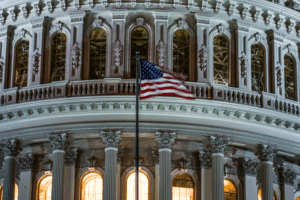
Technology: US Targets 50% Chip Self-Sufficiency
Andy Li, CFA - Senior Analyst, Technology, CreditSights
Jordan Chalfin, CFA - Head of Technology, CreditSights
Michael Pugh - Associate Analyst, CreditSights
30 September 2025
Insights into US semiconductor self-sufficiency strategy, including:
- Aggressive US Policy Shift: Explore how the Trump administration’s push for a 50% US semiconductor self-sufficiency target marks a significant escalation from previous sectoral tariff plans.
- TSMC Arizona: Key to Reshoring: Learn how TSMC’s $165bn Arizona campus aims to deliver up to 10% of the company’s global wafer output and 30% of its leading-edge capacity by 2030, accelerating US chip independence.
- Industry Impact and Winners: Understand why the US Semiconductor Self-Sufficiency Strategy could benefit US-based fabrication leaders like Intel and Texas Instruments, while raising costs for fabless vendors and hardware OEMs.
- Margin and Supply Chain Pressures: See how reshoring and tariffs will pressure margins—especially for advanced node fabless companies—and force supply chain adjustments to secure domestic capacity.
- Feasibility and Timeline Uncertainty: Get insights on critical unknowns, including the grace period for compliance, the scope of chip categories affected, and the practical challenges of meeting the 50% self-sufficiency benchmark.
Executive Summary
-
The Trump administration is reportedly considering a 50% self-sufficiency target for US semiconductor needs as it nears the conclusion of its Section 232 investigation; this is significantly more aggressive than prior commentary suggesting that merely building in the US would exempt companies from anticipated sectoral tariffs of 100%.
-
The 50% self-sufficiency target seems feasible assuming a ~5 year time horizon, mostly on the back of TSMC Arizona’s 6-fab campus buildout; we estimate that ~10% of TSMC’s total output and 20-30% of its leading-edge production could be supported by the Arizona project, though timelines will likely need to be accelerated.
-
Our base case assumption is that there will be a multi-year grace period as the industry ramps up to the 50% self-sufficiency target, but customers will feel pressured to book domestic capacity as soon as it becomes available.
-
This development is incrementally negative for the overall tech sector (especially leading-edge fabless vendors and hardware OEMs) on higher production costs and potential tariffs; semi fabrication companies with large US footprints such as Intel and Texas Instruments could stand to benefit.



